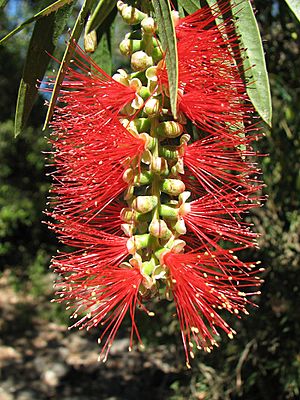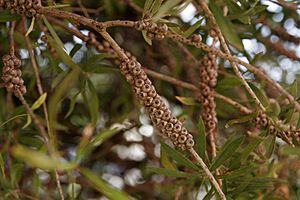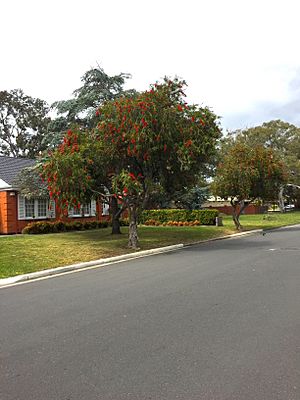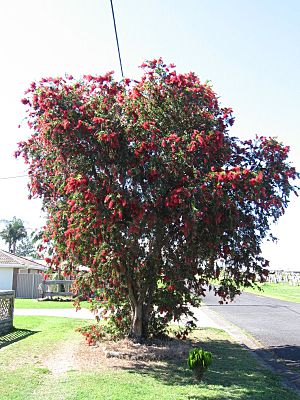Callistemon facts for kids
Quick facts for kids Callistemon |
|
|---|---|
 |
|
| Red bottlebrush flower | |
| Scientific classification |
|
| Kingdom: | Plantae |
| Clade: | Tracheophytes |
| Clade: | Angiosperms |
| Clade: | Eudicots |
| Clade: | Rosids |
| Order: | Myrtales |
| Family: | Myrtaceae |
| Subfamily: | Myrtoideae |
| Tribe: | Melaleuceae |
| Genus: | Callistemon R.Br. |
Callistemon is a group of shrubs that are part of the Myrtaceae plant family. They were first officially named as a group in 1814. These plants are originally from Australia. However, people now grow them in many other parts of the world. In some places, they have even started growing naturally outside of gardens. Some scientists think that Callistemon plants are so similar to another group called melaleucas that they should actually be considered the same type of plant.
Contents
What Bottlebrush Plants Look Like
Callistemon plants are often called bottlebrushes because their flowers look just like the brushes used to clean bottles! They are long and cylindrical, with lots of tiny parts sticking out.
You can mostly find these plants in the cooler parts of Australia, especially along the east coast. They usually like wet places, so if you plant them in a garden, they need regular watering to grow well. However, some types of bottlebrushes can be found in Tasmania and Western Australia. Some kinds can even handle dry weather and are used to make gardens look nice around the world.
Naming the Bottlebrush
The name Callistemon comes from two Greek words: 'callis' which means beauty, and 'stemon' which means stamen. This name describes the beautiful, brush-like flowers of the plant.
The Callistemon group was first officially named in 1814 by a botanist named Robert Brown. He noticed that these plants had flowers similar to Melaleuca plants. For a long time, scientists kept Callistemon and Melaleuca as separate groups.
However, in 1998, some scientists started to combine them. They found that many Callistemon plants were very similar to Melaleuca plants, especially when looking at their DNA. Today, some plant experts and gardens still use the name Callistemon, while others have started calling them Melaleuca. It's a bit confusing, but it shows how scientists are always learning more about plants!
Growing Bottlebrush Plants
Many plant nurseries still sell these plants under the name Callistemon. You can grow new bottlebrush plants from cuttings (small pieces of the plant) or from their seeds.
Bottlebrush plants usually bloom in spring and early summer, which is from October to December in Australia. But sometimes, they might flower at other times of the year too. The most noticeable parts of the flowers are the long, colorful stamens, which have pollen at their tips. The actual petals are very small and hard to see.
The flowers come in different colors, depending on the type of bottlebrush. Most are red, but some can be yellow, green, orange, or white. After flowering, each flower head makes many small, three-part seed capsules around the stem. These capsules stay on the plant with the seeds inside until the plant dies or a fire makes them open up and release the seeds. A few types of bottlebrushes release their seeds every year.
Bottlebrush plants can also be grown in pots, which is great for smaller gardens or balconies. They have been grown in Europe since 1789, when a type called Callistemon citrinus was brought to Kew Gardens in London by Joseph Banks.
Gallery
-
Callistemon "Little John" or dwarf bottlebrush - a Callistemon cultivar
-
Tree in bloom in Florida.
See also
 In Spanish: Calistemon para niños
In Spanish: Calistemon para niños















